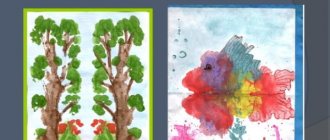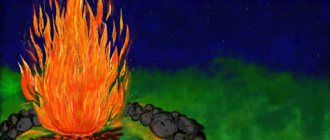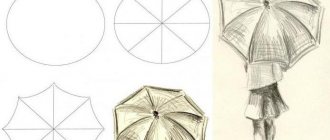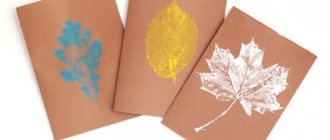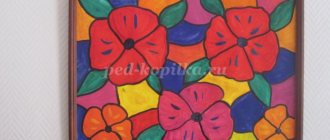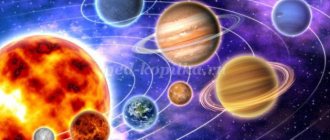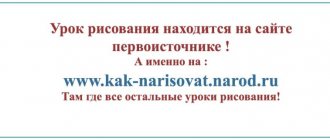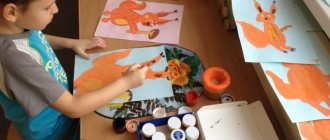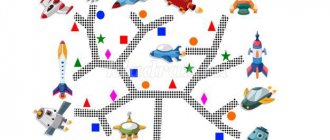Preview:
Municipal budgetary preschool educational institution
"Kindergarten of compensatory type No. 21"
Summary of direct educational activities for the implementation of the educational field “Artistic Creativity”
(senior preschool age)
drawing "Starry sky"
Snezhinsk 2012-2013
Topic: Subject drawing using drawing techniques
raw "Starry Sky"
In the educational field "Artistic Creativity"
- Teach children to depict the starry sky.
- Choose your own color scheme for the stars and background for the night sky.
- Improve technical wet drawing skills.
- Strengthen skills in working with watercolors and wax pencils
- Develop skills of careful and careful handling of materials.
- Develop artistic taste and aesthetic perception by looking at photographs of the starry sky.
In the educational field "Communication"
- Consolidate vocabulary on the topic “Space”
- Strengthen children's ability to answer questions in complete sentences.
- To develop children’s ability to select adjectives for nouns.
In the educational field "Socialization"
- Form the image of “I”, primary gender ideas (boys are masculine, girls are feminine.)
- To instill in children a culture of gender relations.
- Foster a culture of friendly relations in the children's team.
In the educational field "Cognition"
- Strengthen children's knowledge about space, astronauts, stars.
- To consolidate children's knowledge about the properties of a wax pencil.
- Develop fine motor skills of the hands.
In the educational field "Health"
- Preserve and strengthen the physical and mental health of children using finger exercises.
In the educational field "Physical culture"
- Develop dexterity and eye when playing with the ball
Integrative qualities of children: to develop curiosity, mental and speech activity, independence, proficiency in dialogical speech, and the ability to manage their behavior.
Methods and techniques: Org. moment, game "Getting to know each other", showing a photograph, analyzing and showing a sample, questions, working with wax crayons and watercolors, exhibition, result.
Health-saving technologies: finger gymnastics (Sudzhok balls)
Individual work: with Edik and Zakhar, follow the sounds.
Differentiated approach: for 1 subgroup. — offer larger format paper.
Preliminary work: conversation about space, about the first cosmonaut of the Earth Yu.A. Gagarin, about the female cosmonaut V.V. Tereshkova, experimenting with a wax pencil (properties of a wax pencil).
Progress of direct educational activities
Educator: - Look at each other and smile, give a good mood.
Educator: - I have a ball in my hands, we will throw it, calling ourselves and
say who you dream of becoming. Educator: - I'll start first.
Educator: - I am Irina Aleksandrovna, I so dreamed of being a teacher and I became one.
Educator: - And you? (passes the ball to the child standing next to him)
Children: - I am Zakhar, I dream of becoming......
Children: - I am Nastya, I dream of becoming.....etc. 2. Main part.
Educator: - Yes, you each have your own dream.
Educator: - Do you remember I told you a story about a little boy Yura who had an unusual dream?
Educator: - What did Yura dream about?
Children: - Yura dreamed of becoming an astronaut and seeing the starry sky.
Educator: - Did his dream come true?
Children: - His dream came true, he became an astronaut.
Educator: - Boys, which of you would like to become an astronaut like Yu.A. Gagarin?
Educator: - What do you need to be like to become an astronaut?
Children: - Strong, brave, courageous, hardworking, smart.
Educator: - But not only men flew into space, remember who else flew into space?
Educator: - Do you want to know? (children sit in front of the easel)
Educator: - Look how few chairs there are. What should we do, who should we invite to sit on them? (The children’s suggestions are listened to, after which the boys invite the girls to sit and bring chairs for themselves.)
Educator: - Well done, boys, you did everything right!
Educator: - Not only men, but also women conquered space. The first female cosmonaut was Valentina Vladimirovna Tereshkova. Tereshkova became a role model for all women. (Photo)
Educator: - Girls, which of you would like to become an astronaut?
Educator: - What do you need to be like to become an astronaut?
Children: - You need to be strong, brave, courageous, smart...
Educator: - But at the same time she remained a gentle, caring, affectionate, loving mother and wife.
Educator: - So not only boys and men can be strong, brave, courageous, but girls and women can also be strong, brave, courageous...
Educator: - But we won’t be able to go to space with you, but we can draw it.
Educator: - Would you like to draw a starry sky?
3. Sample display and analysis
Educator: - All stars are very different, both in size and temperature. Stars are balls of fire, some hotter than others. That's why the stars have different colors. In the night sky, the stars twinkle with different lights. Have you seen how? (photos of the starry sky)
Children: - The stars twinkle in blue, white, yellow, red.
Educator: - So, what kind of stars are they?
Children: - The stars are colorful, bright, beautiful.
Educator: - Look how I painted the starry sky.
Educator: - In my drawing, the stars are the main object and will occupy most of the composition.
Educator: - What did I use to draw the stars?
Children: - You drew stars with a wax pencil.
Educator: - Don’t forget that the stars are multi-colored and different in size.
Educator: - Then I moisten a sheet of paper with water, using a wide brush, and only then apply black or blue watercolor on top of the drawing, leaving no unpainted areas. Artists call this drawing technique “raw.”
Educator: - How do you understand the word “raw”?
Children: - Wet, wet.
Educator: - Who knows why the watercolor did not paint over the stars?
Children: - Because a wax pencil contains wax, and it repels any liquid from its surface.
Educator: - Before starting work, let’s warm up our hands (Sudzhok balls).
Educator: - And if your hands get tired, then you can rest (roll wax pencils between your palms).
4. Working with wax pencils and watercolors.
(music background is created)
Educator: - Sit in your seats, do not forget that your back should be straight, your legs should be side by side (boys help move the chairs for girls)
Educator: - Remember where you will start your work, what color the stars are, the stars should occupy most of the sheet.
Children's works are placed on the board, children are invited to examine them
Educator: - And our dream also came true today, like Yuri Gagarin, let's admire your works, what a beautiful sky you painted.
Educator: - What is this drawing technique called?
Educator: - Girls, who liked what work and why?
Educator: - Boys, who liked what work and why?
Educator: - I liked all the works.
Educator: - The boys are great, the girls are smart, the work is all different, not alike, everyone got their own starry sky!
Educator: - And at home you can teach how to draw mom and dad.
Source
Slide captions:
“The Cheerful Artist” Topic: “Starry Sky” (spraying + foam stencil printing) Municipal budgetary preschool educational institution “Atemar kindergarten No. 1 “Teremok” of the Lyambirsky municipal district of the Republic of Mordovia Prepared by: head of the “Cheerful Artist” circle Olga Aleksandrovna Ryabova
Goal: - to teach the child how to perform the technique of “splash painting”, “foam stencil printing” - to develop creative abilities and aesthetic taste; cultivate perseverance, patience, accuracy.
On April 12, our country celebrates Cosmonautics Day. On this day in 1961, our planet was shocked by the unexpected news: “Man in space!” People's dream of flying into space has come true. On an April morning, the first cosmonaut Yuri Alekseevich Gagarin flew into space on the Vostok-1 spacecraft. The flight around the Earth lasted 108 minutes. The starry sky has always attracted the eyes of people, beckoning with its uncertainty. People dreamed of learning as much as possible about space. Thus began the time of space rockets, satellites, and lunar rovers. Talk to your child, tell him about the Cosmonautics Day holiday, about the first cosmonaut, about space.
Our Earth is a huge ball on which there are seas, rivers, mountains, deserts and forests. And also people live. Our Earth and everything that surrounds it is called the Universe, or space. In addition to our blue planet, there are others, as well as stars. Stars are huge balls of light. The sun is also a star. It is located close to the Earth, so we see it and feel its heat. We see stars only at night, and during the day the Sun eclipses them. There are stars even bigger than the sun
Today we will draw a starry sky using the spray technique. For work we will need: - a sheet of blue or purple paper; -paints; -toothbrush and stack; - a small piece of foam rubber; - “star” stencil. Offer to draw a starry sky using unusual techniques.
Dip a toothbrush into the yellow paint and use a paint brush to splatter it onto the sheet.
Place the stencil on the sheet, dip a piece of foam rubber into the paint and carefully apply it along the “star” stencil.
You will get a beautiful starry sky!
Advice for parents. Watch the starry sky with your children. Don’t be lazy in the evening to go out to the balcony and admire the stars. Show your child some constellations, try to find the Big Dipper together. Tell us that ancient people peered into the night sky, mentally connected the stars, drew animals, people, objects, and mythological heroes. Find a star chart and show your child what the constellations look like, and then together find them in the sky. This develops observation and memory. The space theme contains a lot of ideas for drawings and crafts. You can draw, sculpt astronauts, aliens, the Moon. Come up with new names for stars and planets. In general, use your imagination; the theme of space is limitless and interesting for children.
On the topic: methodological developments, presentations and notes
An integrated final lesson-celebration in the preparatory group for art and physical education, dedicated to the 65th anniversary of the victory. Children do a lot of collective work using both traditional ones.
The integrated lesson “And the sky without birds is not the sky, and the sea without fish is not the sea, and the earth without animals is not earth” was conducted in a preparatory group for school. The lesson uses riddles and poetry.
Summary of an integrated lesson on the topic “What do we see in the sky?” (integration of types of children’s activities: playful, cognitive, communicative, productive.) Goal: To develop children’s cognitive skills.
· Expansion of vocabulary · Introduce children to the symbolism of constellations accepted by astronomers, cultivate a love of nature.
GCD plan No. 18 “.Autumn. Migratory birds" "Clouds in the sky" (gouache) Integration of educational areas: "Health", "Physical education", "Safety", "Cognition", "Communication.
Integrated direct educational activities in the senior group (educational area “Cognition”, “Physical Education”, “Reading Fiction”, “Artistic Creation.
Source
